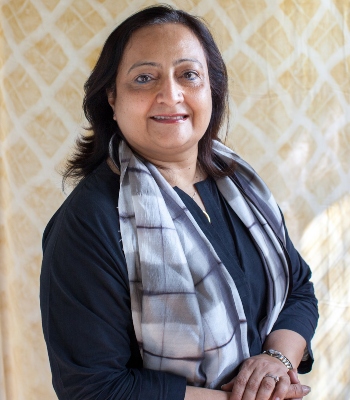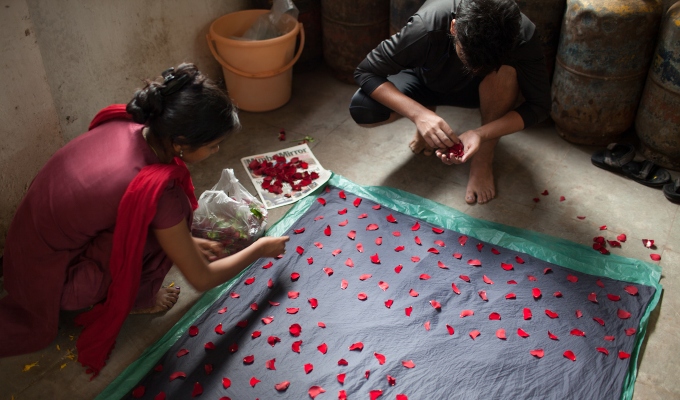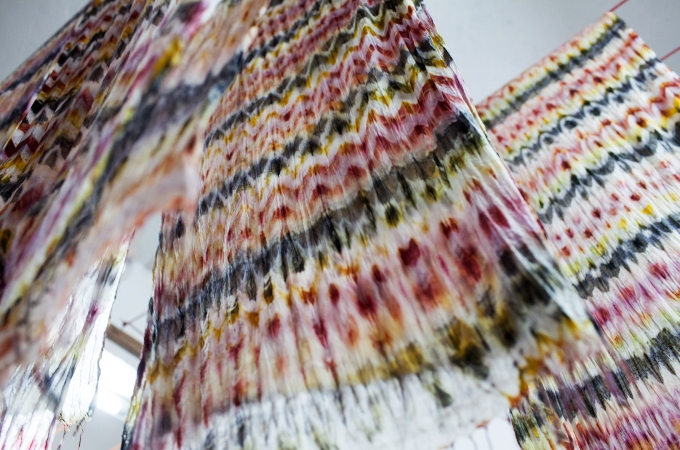On World Environment Day, a look at how a Mumbai designer recycles discarded temple offerings to make natural dyes for artisanal textile
Images of the Arabian Sea spewing back tons of garbage onto Mumbai’s beaches often go viral. They show an angry high tide dumping back all the garbage that Mumbaikars have been throwing into the sea all these years. Andheri (Mumbai)-based textile designer Rupa Trivedi says, “Living by the sea, I see the pollutants on a daily basis.” As founder of Adiv Pure Nature, a social enterprise based in Mumbai, Trivedi has been working to create a sustainable, green fashion supply chain by making natural dyes for textiles.
Looking at garbage floating in the sea, it was discarded temple flowers that first caught her eye. “The number of flowers and other offerings would especially peak during festival season,” says Trivedi who was already making natural dyes from plants and herbs. She would use the dyes to craft artisanal textiles for commercial use. “I was keen to use discarded flowers like marigolds,” says the designer.

Rupa Trivedi, founder of Adiv Pure Nature.
The Temple Blessings Project
As per tradition, devotees offer flower garlands in temples to invoke blessings of the reigning deities. These wilted flowers are gathered every few days and discarded in the sea as per Hindu custom. It was in 2008 that Trivedi began approaching temples. “It wasn’t easy to begin with,” reminisces the designer who found that the discarded waste included not just flowers but coconuts and some plastic and cloth material too. “Space is a huge constraint in Mumbai and my studio wasn’t enough to help segregate the waste,” says Trivedi. A meeting with the chairperson of the Siddhivinayak Temple in Mumbai helped her gain access to the segregated ‘temple blessings’. Dedicated to Lord Ganesha, the Hindu elephant god, Siddhivinayak is one of India’s most visited temples. “It sees approximately 4.8 million worshippers a month and about 500 kgs of temple offerings per day,” informs Trivedi. However, the use of the segregated floral offerings came with a clause. “After use, it had to be sent to a composting unit. It was the perfect solution and since then we have been collecting and using the flowers from the temple,” says Trivedi.

Artisans placing rose petals for dyeing process.
Basket of Hues
Apart from the popular marigold, rose and hibiscus, Trivedi also uses coconut husk to make natural dyes and steamed textured prints. “I also collect green coconut from street vendors in Mumbai and extract colour out of them,” explains the designer who feels natural textiles like silk and cotton should not be treated with chemical colourants when nature offers it all. For instance, when used on fabric, coconut gives a soft melon pink hue that is very soothing to the eye. And when steam-treated, hibiscus yields a dark blackish-purple on the fabric. As a dye, marigold yields the traditional, bright yellow associated with its petals and also rich mustard, deep fern and fresh leafy green. Onion skins give a pleasing light yellow and a dark mossy green on a variety of textiles. “Adiv’s hand-dyeing team creates natural-dyed fabrics woven by weavers from Maharashtra, West Bengal, and Maheshwar (Madhya Pradesh) to craft scarves, garments, jewellery and more,” she shares.
Comprising of 28 young, self-taught artisans, two Saturdays in a month are dedicated to experimentation at the Adiv studio. “We even keep a daily journal to ensure results can be replicated,” informs Trivedi. The team also collects organic onion skins from an organic farmers market every week.

Dropper print process at Adiv Pure Nature.
The Future is Sustainability
Having worked with an international clientele, including well-known labels like Eileen Fisher, Anthropologie and Christina Kim-run Dosa, Trivedi has recently been featured in the book True Colors: World Masters of Natural Dyes and Pigments by Kieth Recker. The book documents work by artists who create colour from natural materials and about the historical importance and environmental sustainability of this practice. “The art of making natural dyes offers sustainable options to the world of fashion. It is commercially viable. We just need to take the steps in the right direction,” says Trivedi. Come July and Adiv Pure Nature would pitch a tent at the popular International Folk Art Market in Santa Fe, New Mexico (the US), under the category – Innovation and Sustainability.
Reference: https://thevoiceoffashion.com/sustainability/tvof-likes/temple-flowers-to-artisanal-textile-2621

